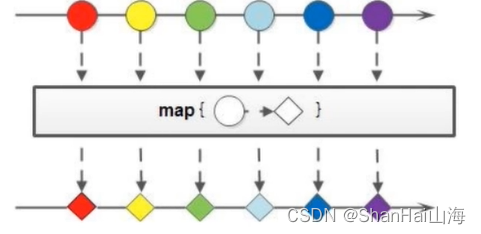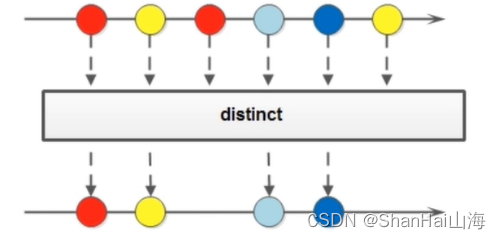一、Lambda表达式
Lambda表达式是一个匿名函数,可以理解为一段可以传递的代码。
new Thread(()->{
System.out.println("线程Lambda表达式"+ Thread.currentThread().getName());
}).start();
Lambda表达式的优点:简化了匿名内部类的使用,语法更加简单。
匿名内部类语法冗余,体验了Lambda表达式后,发现Lambda表达式是简化匿名内部类的一种方式。
1、语法规则
Lambda省去了面向对象的条条框框,Lambda的标准格式由三个部分组成:
(参数类型:参数名称)->{
代码体;
}
格式说明:
- (参数类型:参数名称):参数列表
- (代码体;):方法体
- ->:箭头,分割参数列表和方法体
2、原理
匿名内部类的本质是在编译时生成一个Class文件。xxx$1.class
Lambda表达式在从程序运行的时候会形成一个类。
1、在类中新增了一个方法,这个方法的方法体就是Lambda表达式中的代码。
2、还会形成一个匿名内部类,实现接口,重写抽象方法。
3、在接口汇总重写方法会调用新生成的方法。
而写有Lambda表达式的class文件,无法通过反编译工具查看,需要通过jdk自带的一个工具:javap 对字节码进行反汇编操作。
javap -c -p 文件名.class
-c:表示对代码进行反汇编
-p:显示所有的类和成员
3、Lambda表达式的省略写法
在lambda表达式的标准写法基础上,可以使用省略写法的规则为:
1、小括号的参数类型可以省略
2、如果小括号内有且仅有一个参数,则小括号可以省略
3、如果大括号内有且仅有一个语句,可以同时省略大括号,return关键字及语句分号
4、Lambda表达式的适用前提
Lambda表达式的语法是非常简洁的,但是 Lambda表达式不是随便使用的,使用时有几个条件需要特别注意
1、方法的参数或局部变量类型必须为接口才能使用Lambda
2、接口中有且仅有一个抽象方法(@FunctionalInterface)
5、Lambda和匿名内部类的对比
Lambda和匿名内部类的对比
- 所需类型不一样
1、匿名内部类的类型可以是类、抽象类、接口
2、Lambda表达式需要的类型必须是接口 - 抽象方法的数量不一样
1、匿名内部类所需要得接口中的抽象方法的数量是随意的
2、Lambda表达式所需的接口中只能有一个抽象方法 - 实现原理不一样
1、匿名内部类是在编译后形成一个class
2、Lambda表达式是在程序运行的时候动态生成calss
二、函数式接口
1、Supplier
无参有返回值的接口
@FunctionalInterface
public interface Supplier<T> {
/**
* Gets a result.
*
* @return a result
*/
T get();
}
2、Consumer
有参无返回值的接口
@FunctionalInterface
public interface Consumer<T> {
/**
* Performs this operation on the given argument.
*
* @param t the input argument
*/
void accept(T t);
3、Function
有参有返回值的接口,Function接口是根据一个类型的数据得到另一个类型的数据,前者称为前置条件,后者称为后置条件。有参数有返回值。
@FunctionalInterface
public interface Function<T, R> {
/**
* Applies this function to the given argument.
*
* @param t the function argument
* @return the function result
*/
R apply(T t);
4、Predicate
有参,返回值为Boolean的接口
public interface Predicate<T> {
/**
* Evaluates this predicate on the given argument.
*
* @param t the input argument
* @return {@code true} if the input argument matches the predicate,
* otherwise {@code false}
*/
boolean test(T t);
三、方法引用
1、方法引用的格式
符号表示:::
符号说明:双冒号为方法引用运算符,而它所在的表达式被称为方法引用
应用场景:如果Lambda表达式所要实现的方案,已经有其他方法存在相同的方案,那么则可以使用方法引用。
2、常见的引用方式
方法引用在JDK8中是相当灵活的,有以下几种方式:
2.1对象名::方法名
instanceNmae::methodName
这是最常见的一种用法。如果一个类中已经存在了一个成员方法,则可以通过对象名引用成员方法。
- 被引用的方法,参数要和接口中的抽象方法的参数一样
- 当接口抽象方法有返回值时,被引用的方法也必须有返回值
2.2类名::静态方法名
ClassName::staticMethodName
也是比较常用的方式。
2.3类名::普通方法(引用实例方法)
ClassName::methodNmae
Java面向对象中,类名只能调用静态方法,类名引用实例方法是有前提的,实际上是拿第一个参数作为方法的调用者。
2.4类名::构造器
ClassName::new 类名::new 调用的构造器
由于构造器的名称和类名完全一致,所以构造器引用使用::new
的格式。
2.5数组::构造器
TypeName[]::new String[]::new 调用数组的构造器
小结:方法引用是对Lambda表达式符合特定情况下的一种缩写形式,它使得我们的Lambda表达式更加的精简,也可以理解为Lambda表达式的缩写形式,不过要注意的是方法引用只能引用已经存在的方法。
四、Stream API
1、Stream流式思想概述
注意:Stream和IO流(InputStream/OutputStream)没有任何关系。
Stream流式思想类似于工厂车间的"生产流水线",Stream流不是一种数据结构,不保存数据,而是对数据进行加工处理。Stream可以看作是流水线上的一个工序。在流水线上,通过多个工序让一个原材料加工成一个商品。
Stream API能让我们快速完成许多复杂的操作,如筛选、切片、映射、查找、去除重复、统计、匹配和归约。
2、Stream流获取方式
2.1 根据Collection获取
首先,java.util.Collection接口中加入了default方法stream,也就是说collection接口下的所有的实现都可以通过Stream方法来获取Stream流。
public static void main(String[] args) {
List<string> list = new ArrayList<>();
list.stream();
Set<string> set = new Hashset<>();
set.stream();
vector vector = new vector();
vector.stream();
}
但是Map接口并没有实现Collection接口,这时我们可以根据Map获取对应的key value的集合。
public static void main(String[] args) {
HashMap<Object, Object> map = new HashMap<>();
Stream<Object> stream = map.keySet().stream();//key
Stream<Object> stream1 = map.values().stream();//value
Stream<Map.Entry<Object, Object>> stream2 = map.entrySet().stream();//entry
}
2.2 根据Stream的of方法
在实际开发中我们不可避免的还是会操作到数组中的数据,由于数组对象不可能添加默认方法,所以Stream接口中提供了静态方法of。
public static void main(String[] args) {
Stream<String> a1 = Stream.of("a1", "a2", "a3");
String[] arr1= {"aa","bb","cc"};
Stream<String> arr11 = Stream.of(arr1);
Integer[] arr2 = {1,2,3,4};
Stream<Integer> arr21 = Stream.of(arr2);
arr21.forEach(System.out::println);
//注意,基本数据类型的数组是不行的
int[] arr3 = {1,2,3,4};
Stream.of(arr3).forEach(System.out::println);
}
3、Stream常用方法介绍
Stream常用方法
Stream流模型的操作很丰富,这里介绍一些常用的API。这些方法可以被分成两种:
| 方法名 | 方法作用 | 返回值类型 | 方法种类 |
|---|---|---|---|
| count | 统计个数 | long | 终结 |
| forEach | 逐级处理 | void | 终结 |
| filter | 过滤 | Stream | 函数拼接 |
| limit | 取用前几个 | Stream | 函数拼接 |
| skip | 跳过前几个 | Stream | 函数拼接 |
| map | 映射 | Stream | 函数拼接 |
| concat | 组合 | Stream | 函数拼接 |
终结方法: 返回值类型不再是Stream类型的方法,不再支持链式调用。本小节中,终结方法包括count和forEach方法。
非终结方法: 返回值类型仍然是Stream类型的方法,支持链式调用。(除了终结方法外,区域方法均为非终结方法)
Stream注意事项(重要)
- Stream只能操作一次
- Stream方法返回的是新的流
- Stream不调用终结方法,中间的操作不会执行
3.1 forEach
forEach用来遍历流中的数据的
void forEach(Consumer<? super T> action);
该方法接受一个Consumer接口,会将每一个流元素交给函数处理
public static void main(String[] args) {
Stream.of("a1", "a2", "a3").forEach(System.out::println);;
}
3.2 count
Stream流中的count方法用来统计其中的元素个数
long count();
该方法返回一个long值,代表元素的个数
public static void main(String[] args) {
System.out.println(Stream.of("a1", "a2", "a3").count());
}
3.3 filter
filter方法的作用是用来过滤数据的。返回符合条件的数据。可以通过filter方法将一个流转换成另一个子集流。
Stream<T> filter(Predicate<? super T> predicate);
该接口接受一个Predicate函数式接口参数作为筛选条件
public static void main(String[] args) {
Stream.of("a1", "a2", "a3", "b1", "b2", "b3")
.filter((s) -> s.contains("b"))
.forEach(System.out::println);
}
输出:
b1
b2
b3
3.4 limit
limit方法可以对流进行截取处理,只取前n个数据
Stream<T> limit(long maxSize);
参数是一个long类型的数值,如果集合当前长度大于参数就进行截取,否则不操作:
public static void main(String[] args) {
Stream.of("a1", "a2", "a3", "b1", "b2", "b3")
.limit(5)
.forEach(System.out::println);
}
输出:
a1
a2
a3
b1
b2
3.5 skip
如果希望跳过前面几个元素,可以使用skip方法获取一个截取之后的新流。
Stream<T> skip(long n);
操作:
public static void main(String[] args) {
Stream.of("a1", "a2", "a3", "b1", "b2", "b3")
.skip(3)
.forEach(System.out::println);
}
输出:
b1
b2
b3
3.6 map
如果我们需要将流中的元素映射到另一个流中,可以使用map方法:
<R> Stream<R> map(Function<? super T, ? extends R> mapper);

该接口需要一个Function函数式接口参数,可以将当前流中的T类型数据转换为另一种R类型数据。
public static void main(String[] args) {
Stream.of("1", "2", "3", "4", "5", "6")
// .map(msg -> Integer.parseInt(msg))效果等同于下面
.map(Integer::parseInt)
.forEach(System.out::println);
}
3.7 sorted
如果需要将数据排序,可以使用sorted方法:
Stream<T> sorted();
在使用的时候可以根据自然规则排序,也可以通过比较器来指定对应的排序规则
public static void main(String[] args) {
Stream.of("1", "22", "23", "2", "4", "6")
// .map(msg -> Integer.parseInt(msg))效果等同于下面
.map(Integer::parseInt)
// .sorted()//根据数据的自然顺序排序
.sorted((o1,o2) -> o2-o1)//根据比较器指定排序规则
.forEach(System.out::println);
}
3.8 distinct
如果要去掉重复数据,可以使用distinct方法:
Stream<T> distinct();

Stream流中的distinct方法对于基本数据类型是可以直接去重的,对于自定义类型,我们需要去重写hasCode和equals方法来移除重复元素。
public static void main(String[] args) {
Stream.of("1", "22", "22", "2", "4", "6")
// .map(msg -> Integer.parseInt(msg))效果等同于下面
.map(Integer::parseInt)
// .sorted()//根据数据的自然顺序排序
.sorted((o1,o2) -> o2-o1)//根据比较器指定排序规则
.distinct()//去掉重复的记录
.forEach(System.out::println);
}
3.9 reduce方法
如果需要将所有数据归纳得到一个数据,可以使用reduce方法
T reduce(T identity, BinaryOperator<T> acumulator);
使用:
public static void main(String[] args) {
Integer sum = Stream.of(1, 2, 3, 4)
//identity默认值
//第一次的时候会将默认值赋给x
//之后每次会将上一次的操作结果赋给x y就是每次从数据中获取的元素
.reduce(0, (x, y) -> {
System.out.println("x=" + x + ",y=" + y);
return x + y;
});
System.out.println(sum);
//获取最大值
Integer max = Stream.of(1, 2, 3, 4)
.reduce(0, (x, y) -> {
return x > y ? x : y;
});
System.out.println("最大值:"+max);
}
结果:
x=0,y=1
x=1,y=2
x=3,y=3
x=6,y=4
10
最大值:4
3.10 map和reduce的组合
在实际开发中,我们会将map和reduce一块使用
public static void main(String[] args) {
Integer sumAge = Stream.of(
new Person("张三", 18),
new Person("李四", 19),
new Person("王五", 20),
new Person("赵六", 21)
// ).map(p->p.getAge)
).map(Person::getAge)//实现数据类型转换,符合reduce对数据的要求
// .reduce(0,(x,y)->x+y);
.reduce(0, Integer::sum);//reduce实现数据的处理
System.out.println(sumAge);
}
3.11 mapTolnt
如果需要将Stream中的Integer类型转换为int类型,可以使用mapToInt方法
![[外链图片转存失败,源站可能有防盗链机制,建议将图片保存下来直接上传(img-BW7JlAZq-1658798400699)(C:\Users\yfzheng.ARCVIDEO\AppData\Roaming\Typora\typora-user-images\image-20220726090439598.png)]](https://img-blog.csdnimg.cn/7d6031cedd304efd89bf2555009f401a.png)
使用:
public static void main(String[] args) {
//Integer比int占用的内存多很多,在Stream流操作中会自动装箱和拆箱操作
Integer[] arr = {1,2,3,4,5,6,7,8};
Stream.of(arr)
.filter(i->i>0)
.forEach(System.out::println);
//为了提高代码的效率,我们可以先将流中Integer数据转换为int数据,然后再操作
IntStream intStream = Stream.of(arr)
.mapToInt(Integer::intValue);
intStream.filter(i->i>3)
.forEach(System.out::println);
}
3.12 concat
如果两个流,希望合并成为一个流,那么可以使用Stream接口的静态方法concat
public static <T> Stream<T> concat(Stream<? extends T> a, Stream<? extends T> b) {
Objects.requireNonNull(a);
Objects.requireNonNull(b);
@SuppressWarnings("unchecked")
Spliterator<T> split = new Streams.ConcatSpliterator.OfRef<>(
(Spliterator<T>) a.spliterator(), (Spliterator<T>) b.spliterator());
Stream<T> stream = StreamSupport.stream(split, a.isParallel() || b.isParallel());
return stream.onClose(Streams.composedClose(a, b));
}
使用:
public static void main(String[] args) {
Stream<String> stream1 = Stream.of("a", "b", "c");
Stream<String> stream2 = Stream.of("x", "y", "z");
//通过concat方法将两个流合并成为一个新的流
Stream.concat(stream1,stream2).forEach(System.out::print);
}
输出:
abcxyz
4、例子
统计个数:list.stream().count
去重: .distinct()
遍历: .forEach(a-> System.out.println(a))
过滤: .filter
限制个数: .limit
跳过: .skip
map映射: .map(a->a+" ")
连接多个数组:Ints.concat()
list转字符串:Joiner.on(“,”).join()
map转字符串:Joiner.on(" , “).withKeyValueSeparator(” = ").join()
list转string:跳过 null:Joiner.on(“,”).skipNulls().join()
list转string:null变为其他值:Joiner.on(“,”).useForNull(“”).join()
根据-切割,将string转为list:Splitter.on(“-”).trimResults().splitToList()
string转为map:Splitter.on(“,”).withKeyValueSeparator(“=”).split()
多个字符进行分割:Splitter.onPattern(“[.|,]”)
每隔n字符进行分割:Splitter.fixedLength(n).splitToList()
取两个集合的并集并去重:listAll.stream().distinct().collect(toList())
List集合去重:list.stream().distinct().collect(toList())
List集合去重:List.stream().collect(collectingAndThen(toCollection(() -> new TreeSet<>(Comparator.comparing(User::getName))), ArrayList::new))
匹配: anyMatch(),只要有一个元素匹配传入的条件,就返回 true。
allMatch(),只有有一个元素不匹配传入的条件,就返回 false;如果全部匹配,则返回 true。
noneMatch(),只要有一个元素匹配传入的条件,就返回 false;如果全部不匹配,则返回 true。
5、Stream结果收集
5.1 结果收集到集合中
操作:
public static void main(String[] args) {
/**
* Stream结果收集
* 收集到集合中
*/
//收集到List集合中
// Stream<String> stream = Stream.of("aa", "bb", "cc");
List<String> list = Stream.of("aa", "bb", "cc", "aa")
.collect(Collectors.toList());
System.out.println(list);
//收集到Set集合中
Set<String> set = Stream.of("aa", "bb", "cc", "aa")
.collect(Collectors.toSet());
System.out.println(set);
//如果需要获取的类型为具体的实现,比如:ArrayList HashSet
ArrayList<String> arrayList = Stream.of("aa", "bb", "cc", "aa")
// .collect(Collectors.toCollection(() -> new ArrayList<>()));
.collect(Collectors.toCollection(ArrayList::new));
System.out.println(arrayList);
HashSet<String> hashSet = Stream.of("aa", "bb", "cc", "aa")
.collect(Collectors.toCollection(HashSet::new));
System.out.println(hashSet);
}
输出:
[aa, bb, cc, aa]
[aa, bb, cc]
[aa, bb, cc, aa]
[aa, bb, cc]
5.2 结果收集到数组中
Stream中提供了toArray方法来将结果放到一个数组中,返回值类型是Object[],如果我们要指定返回的类型,那么可以使用另一个重载的toArry(IntFunction f)方法
操作:
public static void main(String[] args) {
/**
* Stream结果收集收集到数组中
*/
Object[] objects = Stream.of("aa", "bb", "cc", "aa")
.toArray();//返回的数组中的元素是Object类型
System.out.println(Arrays.toString(objects));
//如果我们需要指定返回的数组中的元素类型
String[] strings = Stream.of("aa", "bb", "cc", "aa")
.toArray(String[]::new);
System.out.println(Arrays.toString(strings));
}
输出:
[aa, bb, cc, aa]
[aa, bb, cc, aa]
5.3 对流中的数据做分区操作
Collectors.partitioningBy会根据值是否为true,把集合的数据分割为两个列表,一个true列表,一个false列表

5.4 对流中的数据做拼接
Collector.joining会根据指定的连接符,将所有的元素连接成一个字符串
6、 并行的Stream流
6.1 串行的Stream流
我们前面使用的Stream流都是串行,也就是在一个线程上面执行
public static void main(String[] args) {
Stream.of(5,4,1,2,5,5,8)
.filter(s->{
System.out.println(Thread.currentThread()+""+s);
return s>3;
}).count();
}
输出:
Thread[main,5,main]5
Thread[main,5,main]4
Thread[main,5,main]1
Thread[main,5,main]2
Thread[main,5,main]5
Thread[main,5,main]5
Thread[main,5,main]8
6.2 并行流
parallelStream其实就是一个并行执行的流,它通过默认的ForkJoinPool,可以提高多线程任务的速度。
获取并行流:
public static void main(String[] args) {
/**
* 功能描述:获取并行流的两种方式
*/
ArrayList<Integer> list = new ArrayList<>();
//通过list接口直接获取并行流
Stream<Integer> integerStream = list.parallelStream();
//将已有的串行流转换为并行流
Stream<Integer> parallel = Stream.of(1, 2, 3).parallel();
}
并行流操作:
public static void main(String[] args) {
Stream.of(1, 2, 3, 4, 1)
.parallel()//将流转换为并发流,Stream处理的时候就会通过多线程处理
.filter(s -> {
System.out.println(Thread.currentThread() + "s=" + s);
return s > 2;
}).count();
}
输出:
Thread[main,5,main]s=3
Thread[main,5,main]s=1
Thread[main,5,main]s=4
Thread[ForkJoinPool.commonPool-worker-1,5,main]s=2
Thread[main,5,main]s=1
Stream并行处理的过程会分而治之,也就是将一个大的任务切分成了多个小任务,这表示每个任务都是线程操作。
五、新日期时间API
JDK 8中增加了一套全新的日期时间API,这套API设计合理,是线程安全的。新的日期及时间API位于java.time包中,下面是一些关键类。
- LocalDate :表示日期,包含年月日,格式为2019-10-16
- LocalTime:表示时间,包含时分秒,格式为16:38:54.158549300
- LocalDateTime:表示日期时间,包含年月日,时分秒,格式为2018-09-06T15:33:56.750
- DateTimeFormatter :日期时间格式化类。
- Instant:时间戳,表示一个特定的时间瞬间。
- Duration:用于计算2个时间(LocalITime, 时分秒)的距离
- Period:用于计算2个日期(LocalDate,年月日)的距离
- ZonedDateTime :包含时区的时间
1、日期LocalDate
public static void main(String[] args) {
//创建指定的日期
LocalDate date = LocalDate.of(2022, 2, 22);
System.out.println("data1 = " + date);
//得到当前的日期
LocalDate now = LocalDate.now();
System.out.println("date2 = " + now);
//根据LocalData对象获取对应的日期信息
System.out.println("年:"+ now.getYear());
System.out.println("月:"+ now.getMonth());
System.out.println("月:"+ now.getMonthValue());
System.out.println("月:"+ now.getMonth().getValue());
System.out.println("日:"+ now.getDayOfMonth());
System.out.println("星期:"+ now.getDayOfWeek());
System.out.println("星期:"+ now.getDayOfWeek().getValue());
}
输出:
date = 2022-02-22
now = 2022-07-26
年:2022
月:JULY
月:7
月:7
日:26
星期:TUESDAY
星期:2
2、时间LocalTime
public static void main(String[] args) {
//得到指定的时间
LocalTime time = LocalTime.of(14,22,31,22222);
System.out.println("time:"+time);
//获取当前的时间
LocalTime now = LocalTime.now();
System.out.println("now:"+now);
//获取时间信息
System.out.println(now.getHour());
System.out.println(now.getMinute());
System.out.println(now.getSecond());
System.out.println(now.getNano());
}
输出:
time:14:22:31.000022222
now:14:26:40.822
14
26
40
822000000
3、日期时间LocalDateTime
public static void main(String[] args) {
//得到指定的日期时间
LocalDateTime localDateTime =
LocalDateTime.of(2022,
2,
22,
12,
12,
12,
2222);
System.out.println("localDateTime:"+localDateTime);
//获取当前的日期时间
LocalDateTime now = LocalDateTime.now();
System.out.println("now:"+now);
//获取日期时间信息
System.out.println(now.getYear());
System.out.println(now.getMonthValue());
System.out.println(now.getDayOfMonth());
System.out.println(now.getDayOfWeek().getValue());
System.out.println(now.getHour());
System.out.println(now.getMinute());
System.out.println(now.getSecond());
System.out.println(now.getNano());
}
输出:
localDateTime:2022-02-22T12:12:12.000002222
now:2022-07-26T14:34:56.084
2022
7
26
2
14
34
56
84000000
4、修改、比较
now.with();//修改
now.plus();//加上
now.minus();//减去
//比较
now.isAfter();//是否在后
now.isBefore();//是否在前
now.isEqual();//相等
注意:在进行日期时间修改的时候,原来的LocalDate是不会被修改的,每次操作都是返回了一个新的LocalDate对象,所以在多线程场景下是数据安全的。
5、格式化和解析操作
在JDK8中我们可以通过java.time.format.DateTimeFormatter类进行日期的解析和格式化操作。
public static void main(String[] args) {
LocalDateTime now = LocalDateTime.now();
//指定格式 使用系统默认的格式
DateTimeFormatter isoLocalDateTime = DateTimeFormatter.ISO_LOCAL_DATE_TIME;
//将日期时间转换为字符串
String format = now.format(isoLocalDateTime);
System.out.println("format = " + format);//2022-07-26T15:01:35.752
//通过ofPattern 方法来指定特定的格式
DateTimeFormatter dateTimeFormatter = DateTimeFormatter.ofPattern("yyyy-MM-dd HH:mm:ss");
String format1 = now.format(dateTimeFormatter);
System.out.println("format1 = " + format1);//2022-07-26 15:01:35
//将字符串解析为一个 日期时间类型
LocalDateTime parse = LocalDateTime.parse("1999-06-27 22:55:16", dateTimeFormatter);
System.out.println("parse = " + parse);//1999-06-27T22:55:16
}
输出:
format = 2022-07-26T15:01:35.752
format1 = 2022-07-26 15:01:35
parse = 1999-06-27T22:55:16
6、时区
public static void main(String[] args) {
//获取所有的时区id
// ZoneId.getAvailableZoneIds().forEach(System.out::println);
//获取当前时间 中国使用的 东八区的时区,比标准时间早8个小时
LocalDateTime now = LocalDateTime.now();
System.out.println("now = " + now);//2022-07-26T15:56:27.623
//获取标准时间
ZonedDateTime bz = ZonedDateTime.now(Clock.systemUTC());
System.out.println("bz = " + bz);//2022-07-26T07:56:27.624Z
//使用计算机默认的时区,创建日期时间
ZonedDateTime now1 = ZonedDateTime.now();
System.out.println("now1 = " + now1);//2022-07-26T15:56:27.625+08:00[Asia/Shanghai]
//使用指定的时区创建日期时间
ZonedDateTime now2 = ZonedDateTime.now(ZoneId.of("America/Marigot"));
System.out.println("now2 = " + now2);//2022-07-26T03:59:04.910-04:00[America/Marigot]
}
输出:
now = 2022-07-26T15:59:04.895
bz = 2022-07-26T07:59:04.909Z
now1 = 2022-07-26T15:59:04.909+08:00[Asia/Shanghai]
now2 = 2022-07-26T03:59:04.910-04:00[America/Marigot]
























 299
299











 被折叠的 条评论
为什么被折叠?
被折叠的 条评论
为什么被折叠?










